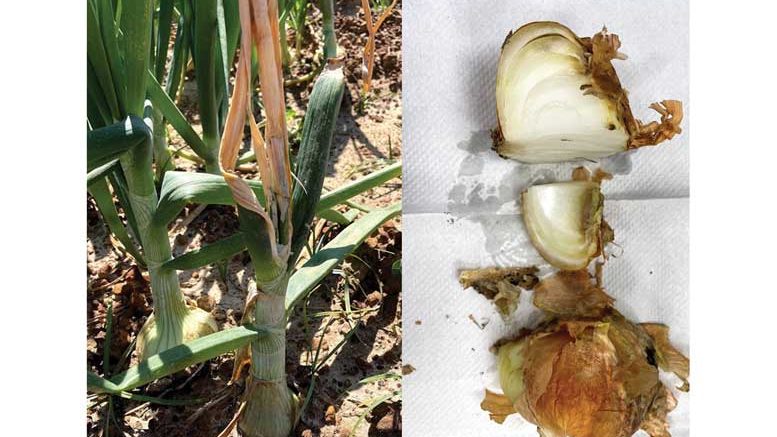|
Click to listen to this article
|
Progress in the Stop the Rot Project in Georgia
By Bhabesh Dutta, Associate Professor and Extension Vegetable Pathologist, University of Georgia; and Mei Zhao, Post-doctoral Research Associate, University of Georgia
Researchers at the University of Georgia (UGA) are learning more about onion bacterial rot – specifically, what causes the problems and how cultural practices influence the effects. Two years into an ongoing research project, the UGA team is sharing their findings and how they hope to develop management recommendations to help growers minimize the impact of onion bacterial rot.
The University of Georgia has been an important part of the USDA-NIFA-Specialty Crop Research Initiative “Stop the Rot” project since its inception in 2019. As part of the project, UGA is involved in a bacterial survey, a specific detection assay for onion-pathogenic bacteria utilizing genomic approaches, assessing cultural practices that influence bacterial bulb rot in the field, standardizing and evaluating the methodology for onion cultivar/germplasm screening and conducting economic analysis. Extension and communication is an integral part of the project. Since 2019, UGA has made important contributions in all the stated objectives of the project.
Bacterial Survey
The overall goal of the bacterial survey is to determine the diversity of bacteria causing infections in onion production in the Vidalia region in Georgia. Onion leaves and bulbs were sampled from multiple fields (January to April) and in storage (May and June).
Survey results indicate seasonal changes in the predominant bacterial genera isolated from onion foliage and bulbs. For example, during the months of January to March (in both 2020 and 2021), pathogenic Pesudomonas spp. and Pantoea spp. formed the predominant bacterial species that could be found in commercial onion fields, mostly as a foliar infection. However, in April and May, apart from Pantoea spp., other bacterial species such as Burkholderia, Rahnella and Enterobacter could also be found.
Bacterial rots that result in maximum culls during grading prior to storage are due to infection caused by Pantoea and Burkholderia. Onion samples that were surveyed after a month of storage (June) were comprised predominantly of Burkholderia. Occurrences of these bacterial genera during different months and different stages of the production cycle is intriguing.
Some of the observations can be explained by the temperature differences experienced in Georgia from January to May. Pseudomonas spp., particularly P. viridiflava, is a cold-loving bacterium, and we often observe limited outbreaks in onion fields during January and February.
From mid-March onward, bacterial infection due to Pantoea takes the upper hand and it continues until harvest. Somehow, the outbreaks of Pantoea spp. infection often coincide with the advent of thrips, the known vector of Pantoea in onions, in the Vidalia onion region. This situation is unique to Georgia and needs further investigation.
As the temperature increases in April and onions get closer to harvest, we experience more Burkholderia infection.
The survey also allowed us to delve deeper into the correct identification of some bacterial species. For example, based on whole-genome sequence, we found that bacterial leaf streak is caused by two distinct Pseudomonas species, the previously identified P. viridiflava and a new Pseudomonas species closely related to Pseudomonas viridiflava.
Cultural Practices
We evaluated the effect of irrigation method, nitrogen (N) rate and the timing of the last N application on bacterial bulb rot. The method of irrigation did not influence bacterial internal rot; however, numerical trends indicate a higher percentage of internal rot with overhead vs. drip irrigated onion plots. This is partly due to more than average rainfall events during February and March of 2020 and 2021, which could have masked the true effect of drip irrigation. Nevertheless, drip irrigation in Vidalia onions, although not widely utilized, can be investigated further for its usefulness in not only water use efficiency but also in reducing bacterial infection.
We also evaluated the effect of N fertility and the impact of the last N application in bacterial rots. We observed that the rate of N did not impact bacterial rots, but the application timing did impact it. The lowest incidence of rot was observed when N was applied two weeks before bulb swelling, while the highest incidences were observed when N was applied either at bulb swelling or two weeks after bulb swelling. In 2021, neither the rate of N nor the timing of the last N application significantly influenced both external and internal bacterial rot. This could be partly explained by considerable low bacterial infection in 2021 vs. 2020. This field trial will be repeated during the 2022 season.
The effects of digging and harvesting methods on the post-harvest incidence of bacterial bulb rot were evaluated. The method of digging had a significant effect on internal bulb rot incidence in storage. Significantly higher incidence of internal rot was observed with the straight-blade undercutter compared with the chain digger. The method of harvest had a significant effect on internal rot in storage. Significantly higher incidence of internal rot was observed with the manual harvest compared with the mechanical harvest.
We also evaluated the impact of clipping length of onion neck on internal bulb rot incidence in storage. We observed significantly higher internal rot when onion necks were clipped at a 1-inch length compared with when clipped at 3- or 5-inch lengths.
Bactericides
We evaluated eight to 10 bactericides and plant-defense inducers in the 2020 and 2021 onion seasons in Georgia. Among the treatments that showed promise in reducing bacterial bulb rots are Mankocide, Kocide 3000, Champ, Nordox, Mastercop, LifeGard and NuCop compared with Actigard and Leap.
The first two years of this USDA project have been fruitful, and during this time, we learned many intricacies that are involved with the biology and management of onion bacterial rot. During the next two years, we will focus on refining our treatments and integrating them into a package that can be extended to our onion growers.
The UGA “Stop the Rot” team is comprised of vegetable extension specialist Bhabesh Dutta, bacteriologist Brian Kvitko, economist Greg Colson, and post-doctoral research associates Mei Zhao and Gi Yoon Shin.


